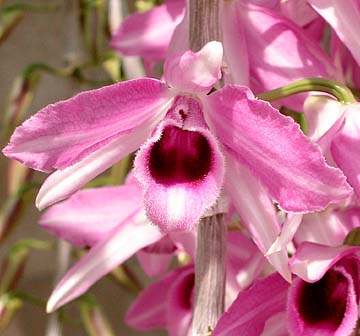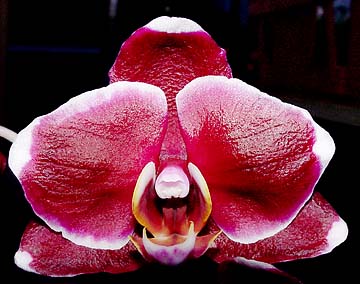


Home & Garden![]()

CRAIG T. KOJIMA / CKOJIMA@STARBULLETIN.COM
Lloyd Esaki's honohonos are bred to produce
beautiful, 3-foot long evenly spaced cascades
of blossoms.
Heavenly honohono
Lloyd Esaki cultivates a fragrant
Get a whiff
treasure at his home in Pearl CityNo matter how many disclaimers Lloyd Esaki adds to his conversation, his reputation as an accomplished cultivator of honohono orchids precedes everything he says -- especially this time of the year, when a profusion of spring blooms permeates his neighborhood with a powerful sweet fragrance.
"You know, I am not really a professional orchid grower," he says as he greets visitors eager to see his award-winning orchids.
"You know, I am nothing more than a hobbyist. I am just a backyard grower," he says, still lingering in his garage.
"You know, I don't really have anything except honohonos," he says, finally inching slowly toward the garden gate.
"OK, you know, this has been a really bad year for me," he says, finally unleashing the gate, "hardly any flowers."
All true -- at least partially true.

|
Esaki is a hobbyist who limits his orchid cultivation to his back yard -- actually two narrow strips along the side of his Pearl City home. His focus is on honohono orchids, although there are a few pots of other types of orchids that he keeps because they came as gifts.The honohono blooms this year are measly compared with previous years when his homemade greenhouse has been filled ceiling to floor with white, pink and lavender blossoms. But the blooms he's managed to coax out of the plants after a cold, wet and windy winter still are impressive.
"Usually they all would be blooming by now," Esaki says as he eyes a large white honohono for display at the Windward Orchid Society's 23rd annual Spring Show and Plant Sale next weekend.
Normally all 12 canes of the white honohono would be in full bloom about this time of the year. It would be a spectacular display with each 3-foot-long cane trailing to the floor laden with white blossoms -- looking like a fountain bursting with white orchids.
But this year, some canes have blooms while the rest either are bare or have only small flower buds. The rest of his plants, save a few, have no flowers at all, only immature buds so far.
"You can't fight Mother Nature. You take what you can get," he says, resigning to his fate this year.
But he still has an advantage over the competition. His plants may not have as many blooms as he'd like, but they are well groomed -- a presentation detail ignored by less particular growers. Esaki's plants are healthy looking, and the canes are even and nicely spaced to show off the blooms.
A new category of competition at next week's show may give him a reprieve, too. A best-fragrance ribbon will be awarded among the usual ribbons for best orchids. (See related story.)
Honohono (Dendrobium anosmum) is noted for its strong perfume, often the star crowd-pleaser at spring orchid shows. It is what Esaki likes the best about his plants. (His wife and neighbors agree.)
Esaki began growing honohonos in 1975 when he received a few as gifts. He was working for the Army repairing binoculars and other optical equipment and never had a fondness for gardening.
"For some reason, the plants just took off," surprising him with robust displays of fragrant flowers, he said. "I don't know why, it's easy for me to grow honohono."
He's never bought a plant, but grew his collection from cuttings made from the original gifts, plus a few other gift plants. After the blooming season, Esaki propagates keiki to ensure fresh blooming plants every year.
Over the years, he's developed a system to govern propagation, watering, fertilizing and the overall care of his plants and has gained a reputation as one of Hawaii's top honohono cultivators. On one side of the house, he nurtures young plants; on the other he houses the mature show-stoppers.
He doesn't know how many plants he'll keep -- likely only enough to fill the two greenhouses. He does not sell his plants but gives away all the extras, and he willingly shares his knowledge with other honohono enthusiasts.
Esaki is a little befuddled by the popularity of the plant, which only blooms in the spring. He remembers them as the only orchids plantation workers could afford when he was growing up in Waiakea on the Big Island.
"It's really a rubbish plant," Esaki says. The Hawaiian name, which isn't known outside of the islands, stuck with the orchid because it's alternating leaves resembled a weedy grass with the same name.
Although many hybrids with fancy colors and varying sizes of blossoms have come on the market over the years, Esaki still loves the common lavender honohono from his childhood.
BACK TO TOP
|

|
Orchid lovers have done it in Japan. So have New Yorkers and maybe their counterparts in South Africa. But on Oahu the Windward Orchid Society will be the first to put the fragrances of orchids to the test. Orchid show to feature
fragrance contestThe society will be staging the first orchid fragrance competition next weekend during its 23rd annual Spring Show and Plant Sale. It will be a new category added to the usual best-orchid awards.
"We thought we'd try to make things interesting," said Aaron Araki, an orchid grower and organizer of the show. "It will be completely subjective, though. Everything will be up to the judges' noses -- whatever they decide they like best."
Some judges may like the more subtle fragrance of cattleya orchids, while others may prefer the strong scent of honohonos. To level the playing field a bit, the society identified five characteristics for the judging: intensity, diffuseness, pleasantness, elegance and instant appeal.
"We don't know how it's going to work out, but it's going to be a lot of fun," Araki said. The public is invited to participate, although only the judges' votes will count.
The show will include bromeliads, African violets, succulents and other plants. Among the plants for sale will be the rare black phalaenopsis, or black butterfly orchid. It comes from Taiwan, and its flowers are not black, but a very deep wine.
Suzanne Tswei, Star-Bulletin Gardening Calendar
Suzanne Tswei's gardening column runs Fridays in Today.
You can write her at the Star-Bulletin,
500 Ala Moana, Suite 7-210, Honolulu, HI, 96813
or email stswei@starbulletin.com